Pacific Prime Can Be Fun For Anyone
Pacific Prime Can Be Fun For Anyone
Blog Article
The Best Guide To Pacific Prime
Table of ContentsExamine This Report on Pacific PrimeWhat Does Pacific Prime Do?Some Known Incorrect Statements About Pacific Prime The Ultimate Guide To Pacific Prime5 Simple Techniques For Pacific Prime

This is due to the fact that the data were accumulated for a period of strong financial efficiency. Of the estimated 42 million people that were uninsured, just about concerning 420,000 (regarding 1 percent) were under 65 years old, the age at which most Americans come to be eligible for Medicare; 32 million were grownups between ages 18 and 65, around 19 percent of all adults in this age group; and 10 million were kids under 18 years old, about 13.9 percent of all kids (Mills, 2000).
These price quotes of the variety of persons uninsured are produced from the yearly March Supplement to the Existing Population Survey (CPS), carried out by the Demographics Bureau. Unless or else noted, national quotes of individuals without health insurance policy and proportions of the population with various kinds of coverage are based on the CPS, the most extensively made use of source of quotes of insurance coverage and uninsurance rates.
A Biased View of Pacific Prime

Still, the CPS is especially useful because it generates yearly quotes fairly rapidly, reporting the previous year's insurance coverage approximates each September, and since it is the basis for a regular set of quotes for greater than two decades, permitting analysis of patterns in insurance coverage with time. For these factors, in addition to the extensive use the CPS in other researches of insurance coverage that exist in this record, we count on CPS price quotes, with restrictions noted.

The estimate of the variety of uninsured individuals broadens when a population's insurance policy condition is tracked for several years. Over a three-year duration beginning early in 1993, 72 million people, 29 percent of the united state population, were without coverage for a minimum of one month. Within a single year (1994 ), 53 million people experienced a minimum of a month without coverage (Bennefield, 1998a)
6 out of every ten uninsured adults are themselves used. Although functioning does improve the possibility that and one's relative will have insurance policy, it is not an assurance. Also participants of families with 2 full-time wage income earners have practically a one-in-ten chance of being without insurance (9.1 percent uninsured price) (Hoffman and Pohl, 2000).
The smart Trick of Pacific Prime That Nobody is Discussing
New immigrants represent a substantial proportion of individuals without medical insurance. One evaluation has associated a substantial portion of the recent development in the dimension of the united state uninsured populace to immigrants that arrived in the country between 1994 and 1998 (Camarota and Edwards, 2000). Current immigrants (those who came to the USA within the past four years) do have a high rate of being uninsured (46 percent), however they and their children account for just 6 percent of those without insurance coverage across the country (Holahan et al., 2001).
The partnership in between health insurance and access to care is well established, as click this documented later in this chapter. Although the relationship between wellness insurance and health outcomes is neither straight neither simple, a comprehensive medical and health and wellness solutions study literary works links medical insurance coverage to enhanced accessibility to care, better high quality, and improved personal and populace health standing.
Levels of evaluation for taking a look at the impacts of uninsurance. This conversation of medical insurance protection concentrates mainly on the U.S. populace under age 65 since practically all Americans 65 and older have Medicare or other public coverage. In addition, it concentrates particularly on those without any health insurance policy for any type of size of time.
The Main Principles Of Pacific Prime
The troubles encountered by the underinsured are in some aspects similar to those encountered by the without insurance, although they are normally less severe. Health and wellness insurance coverage, however, is neither essential neither sufficient to obtain access to medical solutions. The independent and direct result of health and wellness insurance policy protection on access to wellness solutions is well established.
Others will certainly acquire the healthcare they need even without medical insurance, by paying for it expense or seeking it from suppliers who supply treatment complimentary or at extremely subsidized rates. For still others, wellness insurance alone does not make certain invoice of treatment as a result of various other nonfinancial barriers, such as a lack of health treatment companies in their area, limited accessibility to transport, illiteracy, or linguistic and social distinctions.
Unknown Facts About Pacific Prime
Official research concerning without insurance populaces in the United States dates to the late 1920s and very early 1930s when the Committee on the Cost of Medical Treatment created a collection of records about financing doctor office sees and hospitalizations. This problem ended up being significant as the varieties of medically indigent climbed during the Great Clinical depression.
Report this page